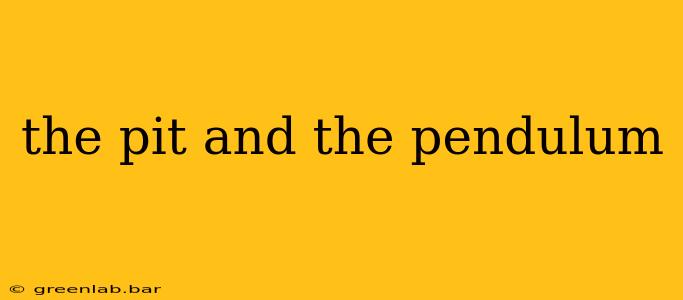Edgar Allan Poe's "The Pit and the Pendulum," a chilling tale of psychological torture, transcends its gothic horror roots to become a powerful exploration of fear, despair, and the resilience of the human spirit. Published in 1842, this short story continues to captivate readers with its vivid imagery, suspenseful pacing, and exploration of the fragility of the human psyche under extreme duress. This analysis will delve into the story's key elements, examining its symbolism, narrative structure, and enduring appeal.
The Sensory Assault: A Masterclass in Suspense
Poe masterfully crafts a narrative that assaults the senses, immersing the reader in the protagonist's terrifying ordeal. The story opens with a sense of overwhelming dread, immediately plunging the reader into the protagonist's fragmented consciousness. He awakens to the oppressive atmosphere of a dark, dank dungeon, his senses bombarded by the chilling sounds and smells of his confinement. This immediate sensory overload sets the stage for the escalating horrors to come.
The Ticking Clock of Dread: Time as a Tormentor
The relentless passage of time becomes a key element of the suspense. The slow, agonizing descent of the pendulum, its rhythmic swing a constant reminder of impending doom, creates a palpable sense of dread. This measured approach to horror is far more effective than sudden shocks, keeping the reader on the edge of their seat, anticipating the inevitable.
The Walls Close In: Claustrophobia and Psychological Warfare
The dungeon itself becomes a character, its oppressive atmosphere mirroring the protagonist's psychological state. The physical confinement, coupled with the psychological torment inflicted by his inquisitors, amplifies the protagonist's feelings of helplessness and despair. The ever-present threat of the pit adds another layer of terror, the unseen abyss representing the unknown and the ultimate consequence of failure.
Symbolism and Interpretation: Unraveling the Deeper Meaning
Beyond its surface-level horror, "The Pit and the Pendulum" is rich with symbolism. The pendulum, a symbol of inescapable fate, represents the protagonist's seemingly inevitable demise. The pit, on the other hand, symbolizes the abyss of despair and the unknown. The rats, scurrying in the darkness, embody the insidious nature of fear and the relentless erosion of hope.
The Inquisitors: Representations of Oppression
The story's antagonists, the shadowy figures of the Spanish Inquisition, are not merely individual characters but represent a broader system of oppression and cruelty. Their actions are symbolic of the power structures that seek to control and suppress individual freedoms. The protagonist's struggle for survival thus transcends a personal battle and becomes a metaphor for the human spirit's resistance to tyranny.
Poe's Legacy: Enduring Influence and Modern Relevance
"The Pit and the Pendulum" remains a cornerstone of gothic literature, influencing countless writers and filmmakers. Its vivid imagery and exploration of psychological torment continue to resonate with audiences today. The story's themes of fear, oppression, and the power of the human will remain timeless and relevant in a world still grappling with similar anxieties. The story's enduring popularity is a testament to Poe's masterful storytelling and the universal appeal of his terrifying vision.
Conclusion: A Timeless Masterpiece of Horror
"The Pit and the Pendulum" is more than just a horror story; it's a psychological exploration of the human condition under extreme pressure. Poe’s skillful use of sensory detail, suspenseful pacing, and powerful symbolism creates a reading experience that is both terrifying and unforgettable. Its enduring appeal speaks to the timeless nature of its themes and the enduring power of Poe's chilling prose.

